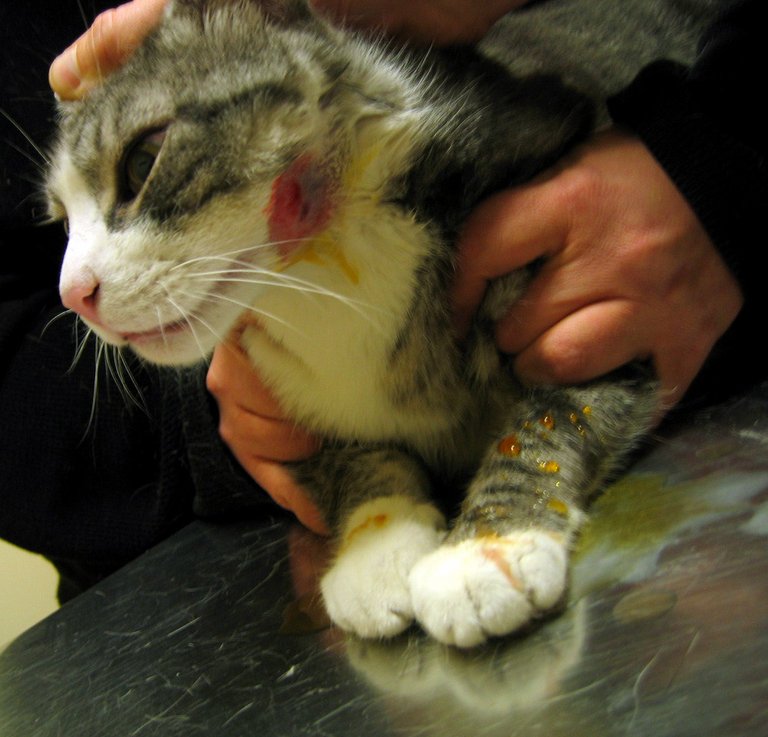The literal meaning of pyoderma signifies ''pus in the skin'', the presence of pyoderma on a pet could be infectious, inflammatory, or neoplastic etiologies. Dogs are usually more susceptible to skin infections based on some basic structural features which include; alkaline PH, absence of a follicular lipid plug that acts as a drain stopper, and a fragile skin barrier.
The major pathogen of the skin for canine is S pseudintermedius, but Staphylococcus schleiferi, Staphylococcus aureus, and Pseudomonas aeruginosa have also been known to contribute significantly to the presence of canine pyoderma.

flickr.com
We also have S aureus which is a human pathogen and has been identified in a low percentage of dogs. This bacterium has however gotten great attention as a result of the methicillin resistance it has in humans, as well as its potential role as a zoonotic agent. Dogs who are infected with this pathogen have most likely gotten the infection from a human.
The pathogen S pseudintermedius is not as virulent as others, but it shares many similar characteristics with S aureus including, the ability to form biofilms, the production of toxins and enzymes, as well as the ability to adhere to matrix adhesive proteins.
The pathogen, Methicillin-resistant S pseudintermedius (MRSP) would most likely be unable to cause human infection, unless in individuals who are extremely young, old, or immunocompromised. P aeruginosa is not common, and has been identified on the skin of dogs, particularly in lip fold pyodermas and post-grooming folliculitis.
Being able to identify the particular Staphylococcus species involved in skin infections, is important when it comes to determining if the dog is infected with a methicillin-resistant strain.
Pyoderma can be classified in different ways, but the classification based on the depth of infected skin is highly useful as it can help to determine the type and duration of therapy.
Surface pyodermas are bacterial infections that are attached to the skin surface. The bacteria produce toxins that lead to inflammation, with the best examples including fold pyodermas of the lips, tail, face, and axilla.

pxhere.com
Superficial pyodermas are bacterial infections that appear beneath the stratum corneum layer of the epidermis, and it's include impetigo, folliculitis, and bacterial overgrowth syndrome as well.
Impetigo is a subcorneal pustular disease that is frequently found on the abdomen of puppies, it may or may not be pruritic, but it is usually self-limiting.
Bacterial folliculitis is an inflammation and infection of the hair follicle, it is the most common type of pyoderma that dogs experience. It has many clinical representations, and sometimes its features are unique to dog breeds.
Bacterial overgrowth syndrome is a superficial cutaneous disorder, that is associated with an overgrowth of S pseudintermedius, it is usually also characterized by a large number of bacteria, erythema, malodor, and pruritus.
Deep pyodermas are less common, and they occur in the form of either focal or localized, generalized or furunculosis, and or cellulitis. Furunculosis is caused as a result of bacterial infections that affect hair follicles and cause little abscesses underneath the skin. We have two types of furunculosis.
Localized form: Usually affects short-coated dogs, any dog affected will usually experience loss of appetite, fever, and malaise before the eruption of the lesions.
Generalized form: This type is not common, but usually accompanies demodicosis. The inflammation is quite serious and dogs are usually systematically ill especially when the infection is deep. Any of the bacteria spoken about before now can cause either surface, superficial, or deep pyoderma.
Superficial pyoderma in dogs will appear as; crusts and scales. follicular papules or pustules, and epidermal collarettes. Deep pyoderma in dogs comes with; pus, crusting, odor, pain, and exudation. In cats, superficial pyoderma is often due to Staphylococcus spp, it is usually underdiagnosed and overlooked.
The most common triggers to superficial pyoderma are; poorly groomed animals, ectoparasites, allergies, keratinization disorders, follicular dysplasias, and endocrinopathies.
To treat pyoderma in a pet, the underlying cause needs to first, be identified, this will help to stop any future recurrence. There is strong evidence that topical therapy helps as the sole treatment of superficial pyoderma, including cases with MRS.
Bathing is an important part of the topical therapy when treating pyoderma in a pet, it helps to make the dog feel, smell, and look better, it helps to clean the skin, take out crusts and scale that contain bacteria, it also helps to compress the course of antibiotics reducing the time for selection of resistant strains.
References
msdvetmanual.com/integumentary-system/pyoderma
todaysveterinarypractice.com/dermatology
